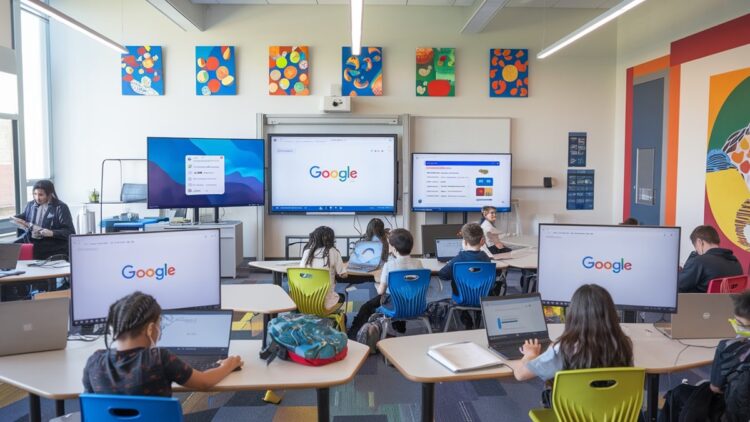
Over the last few years, technology has undoubtedly contributed to almost every profession across the globe. Likewise, it has influenced the world of education by transforming the classical methods of teaching through e-learning and virtual learning system. One of the widely used approach for e-learning is the Google Solutions, through which teachers transform the traditional classroom into a Google-enabled classroom. Google Solutions refers to the utilization of Google Workspace for Education tools to facilitate teaching and learning in the classroom. Google tools comprises Google Chromebook, which is a portable device installed with Chrome OS, through which users may access Google Workspace for Education including Google Classroom, Google Meet, Google Jamboard, Google Cloud, Google Drive, Google Slides, Google Docs, Google Spreadsheets. Keeping in view, Techvalley Pvt Ltd in collaboration with Dr. Wajiha Haq from NUST executed a project for Google. The primary motive of this investigation is to explore how teachers respond when the classes are shifted from the traditional teaching methods to Google enabled classrooms by using Google for Education tools. The objective is to understand how teachers implement Google for education tools and how it may revamp the method of teachings in Pakistan.The primary motive of Project Albus is to explore how Google for Education Tools change the teaching and learning depth in Pakistani classrooms? Accordingly, the research is planned in four phases: Pre-survey, observations, In-depth interviews and Post-surveys. Islamabad Model College for Girls (IMCG), situated in the capital city of Pakistan, is selected to carry out this investigation. The study has been conducted for the period of six months.
The responses from the teachers demonstrated that they were quite satisfied and happy with the facilitation and convenience provided by the Google Solutions. The class quality and content delivery significantly improved with audio and visual aids. These tools have not only eliminated the sole reliance on the course books but also equipped students with updated knowledge. Subsequently, better lecture content helped to gain more student engagement. Likewise, the student-student communication and collaboration improved a lot as students assisted each other in learning the usage of Google tools. Additionally, the use of Google Solutions helped to enhance the classroom command. Similarly, these tools also enabled teachers and students to be a lot more efficient with their time. Furthermore, the use of Google Solutions considerably improved student’s learning capability, studying, elucidating concepts and problem solving.

A few of the distinctive features of this pilot were; firstly, students had to share the Chromebooks due the limitation of the number of devices according to the class strength. The device sharing encouraged and created the environment of group learning. The fast learners in the class took the lead and taught to the slow learners. This was not possible in the traditional class setup. However, the negative aspect was that sometimes device sharing created a distraction for those students who were not in charge of a device control. Secondly, most of these students come from a very poor background, who were not earlier exposed to Chromebooks and internet. Utilization of these devices created a distraction for them, due to the availability of other entertaining material (games & shows) accessible on the internet. On the contrary, these students are full of energy, excitement to learn, and enthusiasm. If these emotions are directed towards proper educational learning, these kids may learn and grow exponentially.

In the second phase, the same survey was done in private schools and it was found that socio-economic status of students and previous interaction with digital gadgets played a significant role in the success of the project.

In many developing nations, where accessing education remains a persistent challenge across multiple regions, Google for Education tools play a crucial role in advancing digital learning. These tools provide an online learning platform, which is vital for reaching remote areas lacking traditional educational infrastructure. They simplify the distribution of educational resources, facilitate digital assessments, and foster collaboration among students and educators. Considering the current state of Pakistani schools, where digital transformation has yet to be fully utilized, Google Solutions offer an excellent opportunity to surmount this obstacle and expand learning beyond physical classrooms. Despite encountering various infrastructural and managerial hurdles, integrating Google Solutions in education yields significant benefits that outweigh these challenges. It is clear that these tools hold the potential to transform education in Pakistan, making it more accessible and inclusive for all.
The author is an Associate Professor, at School of Social Sciences and Humanities (S3H), National University of Sciences and Technology (NUST). She can be reached at dr.wajihahaq@s3h.nust.edu.pk.
Research Profile: https://bit.ly/3BTkG8y

![]()




